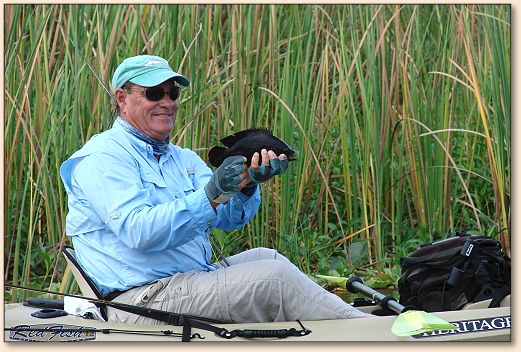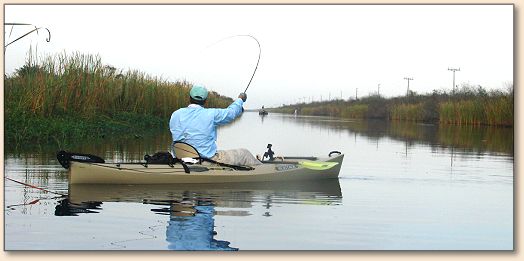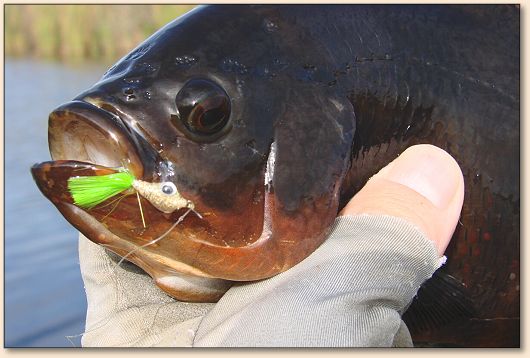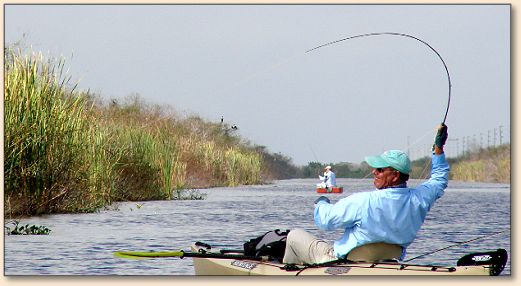|
Al White is a professional saltwater fishing guide who has
caught virtually everything in marine waters throughout the
world.
White, who resides in Rotonda, Fla., on fly rod has bested
bonefish, cobia, tarpon, permit, king mackerel, wahoo, dolphin,
roosterfish, spotted seatrout, roosterfish, sharks, redfish,
snook, tripletail, snapper and just about every species of tuna.
Despite all of his saltwater conquests, White was as excited as
a 5–year–old on Christmas morning about his first
fishing venture into the Florida Everglades.
His targets were the exotics: Oscars and Mayan Cichlids. He had
never seen either, let alone caught them. And, to make it
interesting, he was making his first kayak–fishing expedition.
The Florida Everglades is a vast expanse of subtropical
marshland that is comprised of portions of five counties:
Broward, Palm Beach, Collier, Miami–Dade and Monroe.
It's a veritable paradise for anglers, hunters, naturalists,
outdoor enthusiasts and tourists.
The Everglades is a natural for kayak fishing. There are countless
places to launch and access is moderately easy.

Capt. Al White of Rotonda, Fla., tangles with a feisty oscar on a
canal along Alligator Alley.
On this outing, Alligator Alley, a portion of Interstate 75 that
begins just south of Naples and crosses the state into Broward County,
was the destination.
The 'Glades are a 2–hour drive from where White and I live.
I picked White up at 5 a.m. at Exit 170, and we arrived at a
recreation area off Alligator Alley at mile marker 40 at 7.
There is a nice boat ramp and ample parking.
I'd fished these waters several times during the spring when
the water was down. Fishing was wonderful, with largemouth bass,
bluegill, stumpknocker and Mayan cichlids plentiful. Oscars were
a pleasant incidental catch.
For those who might not be aware, Mayan Cichlids and Oscars are
exotic fish that found their way into South Florida waters in
the 1950s. The subtropical fish more than likely were pets in
someone's aquarium. That person, for reasons unknown, dumped
the aquarium into a backyard pond or canal.
The rest is history.
Both species are pretty much restricted to the southern part
of the state, where the water temperature rarely dips into the
50s. Oscars and Mayan Cichlids cannot tolerate water that's 55
degrees or less. So, most anglers have never experienced the
thrill of the exotics.
Both species are small. Mayan cichlids grow to about 1 ½ pounds.
Oscars can grow to as large as three pounds, but average about
a pound.
I'm a kayak fishing guide (www.kayakfishingsarasota.com) and
have a fleet of Heritage Redfish 12–footers. All are
equipped with rudders, rod holders and anchor trolley systems.
They're perfect for the 'Glades.

Al White leans on an oscar in order to get the fish away from the
structure.
When we arrived at our destination, I noticed the water was up
slightly from the last time I'd fished here. I figured that
would mean the fish had plenty of water and would be distributed
over a vast expanse. During low water, they fall into the canals
and are relatively concentrated.
It didn't take long to figure out there were plenty of fish
in the canal. White, using a 3–weight fly rod, floating
line, 7 1/2 –foot leader and a popping bug, quickly hooked
up to a beefy fish. Turned out to be an hefty Oscar.
Oscars often are compared to bluegill because of their size.
But that's where the comparison ends. If you put an Oscar
and a bluegill in a boxing ring, the fight would be over
within a few seconds. Oscars are schoolyard bullies. They're
mean, aggressive and very strong.
They're so strong that you're forced to go with a little heavier
tippet than you might think. Typically, 6X would be plenty for
most Florida panfish. However, when it comes to Oscars, you'll
need to beef up to 3X.

This oscar fell for a Myakka Minnow, a fly that mimics tiny
minnows in Florida's freshwater lakes, streams and canals.
That might sound like overkill, but it's not. Oscars are
structure–oriented fish and their first move is to
take you right back into the thick vegetation or root systems.
For those who scoff, let's make a side bet. I'm betting that
you'll lose more fish than you land if you go any lighter.
Last spring, Mark Phelps, a professional saltwater fishing guide,
accompanied me on a trek to the 'Glades. That morning, we fooled
around with a variety of fish and did quite well. After lunch,
I told him that I would take him to "Big Oscarville," an area
I'd discovered about a year prior. It was about a 30–minute
paddle away and was comprised of fallen trees, a favorite Oscar
hangout.
When we arrived, I instructed Phelps to cast as close as he
could to the trees. He was using a No.10 chartreuse popping bug.
"Pop it once and then let it sit," I said.
Phelps was the perfect student and did exactly as instructed.
"There's a Oscar right below my popper!" he yelled. "He's going to eat it!"
Phelps set the hook, but he wasn't prepared for the strength or
quickness of the fish.
When the Oscar decided to head for cover, there was nothing
Phelps could do. He tried to apply pressure, but it was not
enough. The Oscar, surely a 2–pounder, won going away.
Phelps had a choice: palm the reel to stop the run or lose
the fish to the cover. He palmed the reel. When he did, the
rod arched violently and the tippet broke.
He repeated the scene twice more in succession.
"You can handle 125–pound tarpon on fly rod, but these little
old Oscars are tearing you up!" I yelled, trying as hard as I could
not to laugh.
White learned first–hand about the strength of Oscars.
He hooked one right off the bat on his 3–weight.
"What in the world do I have?" he asked out loud. "This is one strong fish."

White shows off an oscar that he caught
on a 3-weight fly rod, floating line and a Myakka Minnow.
It was the first of many Oscars on the day. After a quick photo,
the Oscar was released.
Oscars are thick and meaty. They're excellent on the table.
However, as with most Everglades fish, they contain mercury.
So, consumption must be limited. In our case, consumption is
avoided.
On this particular canal, Oscars always were an incidental catch.
This time, they were the primary catch. In fact, it turned out to
be the best day of Oscar fishing I've ever experienced. Not only
were they plentiful and cooperative, but they were large. They
averaged a pound, with the largest pushing a pound and a half.
A friend of mine, Marty Arostequi, a retired Coral Gables physician,
holds most fly–rod Oscar world records. He owns the 2–pound
tippet mark (2.0 pounds), 4–pound (2.0), 6–pound (1–14),
8–pound (2.0), 12–pound (2.0) and 16–pound (1–14).
He shares the 20–pound tippet mark of 2 pounds, 4 ounces with
Rebecca Reynolds–Wright. All but his 20–pound tippet fish
were taken in South Florida. That one was caught on the Unini River
in Brazil.
Surely White came close to a record. But the trip wasn't for
record purposes. In fact, we didn't have a scale or measuring
device. It was catch, release and cast for more.
"You told me there were big bluegill in here," White said. "All
I'm getting are these damned Oscar."
Of course, he was kidding.
The topwater bite usually lasts until midday. However, it was
slow to begin with and died after about 30 minutes.
No problem.
I designed a fly just for such situations. My Myakka Minnow
was born after a fruitless trip on the Myakka River near my
Sarasota home. That day, I watched as bass and bluegill
attacked schools of tiny minnows and sent them scurrying.
I'd cast to them, but came up empty every time.
Evidently, the fish were so keyed into the size that my No. 10
popper didn't appeal to them.
This is a case where size is everything. Normally,
warm–water fish aren't so picky. But there are times,
and this was one.
When I got home, I sat down at my tying table and tried to come
up with a fly that would approximate the size of the tiny minnows.
After several tries, I hit the jackpot. I tied a fly
on a No. 12 hook that mimicked the diminutive minnows
perfectly.
I used chartreuse marabou for the tail. The body is Bodi–Braid
by Spirit River. Before I build up the body into a minnow shape, I
add six to eight turns of .20 lead wire. I used 3D press–on
prism eyes and then coat the fly with Devcon Two–Ton Epoxy.
The fly is easy to cast and very appealing to the fish.
You can tie the Myakka Minnow on any size hook. So, it can
be used for a variety of fish. Over the years, I've taken
bass, bluegill, speckled perch (crappie), shellcracker,
stumpknocker, catfish, sunshine bass, snook, spotted seatrout,
ladyfish, bluefish, Spanish mackerel, little tunny, mangrove
snapper, lane snapper and cobia on the fly. Last spring, I
caught several barramundi on it.
The fly often saves the day when the topwater bites subsides.
"That's one heckuva fly you've got there," said White. "These
fish are whacking the heck out of it."
Key to fishing the fly is a slow retrieve. I like to cast it
out, let it sink to the desired depth, then strip it in
erratically. I prefer strip–strip, pause. Short strips
are best.
Additionally, I like to use a strike indicator set according
to the dept of the water. In the Everglades, I usually place
the strike indicator about 4 feet above the fly.
The fly didn't let us down on this trip. We caught about 60
Oscar, 30 Mayan Cichlids, 40 bluegill, 30 stumpknocker and
two gar. I also managed a fat, 2–pound largemouth bass.
We both lost a number of flies to Oscars that managed to get
back into the structure. Sometimes, there's just not much you
can do to avoid it.
White did well on his first 'Glades experience. He was impressed.
"I can't believe the strength of those Oscars," he said.
"They're something else."
He not only hooked plenty of fish that day, but also found
himself hooked – on Oscars. ~ Steve
About Steve:
Steve Gibson is a professional outdoor writer and kayak
fishing guide who resides in Sarasota, Fla., his work
has appeared in Florida Sportsman, Saltwater Fly Fishing,
Fly Fishing in Salt Waters, Gulf Coast Angler, Florida
Fishing Weekly, Cabela's Online Magazine and other
publications. Born in Huntington, W.VA., he graduated
in 1971 from Marshall University with a B.A. in Journalism.
He served in the United States Air Force from 1971 to 1975.
He has been the outdoor editor of the Sarasota Herald–Tribune
for the past 32 years. He resides in Sarasota, Fla., with his
wife, Kathy, and their Jack Russell Terrier, Jack. His website
is www.kayakfishingsarasota.com.
|




